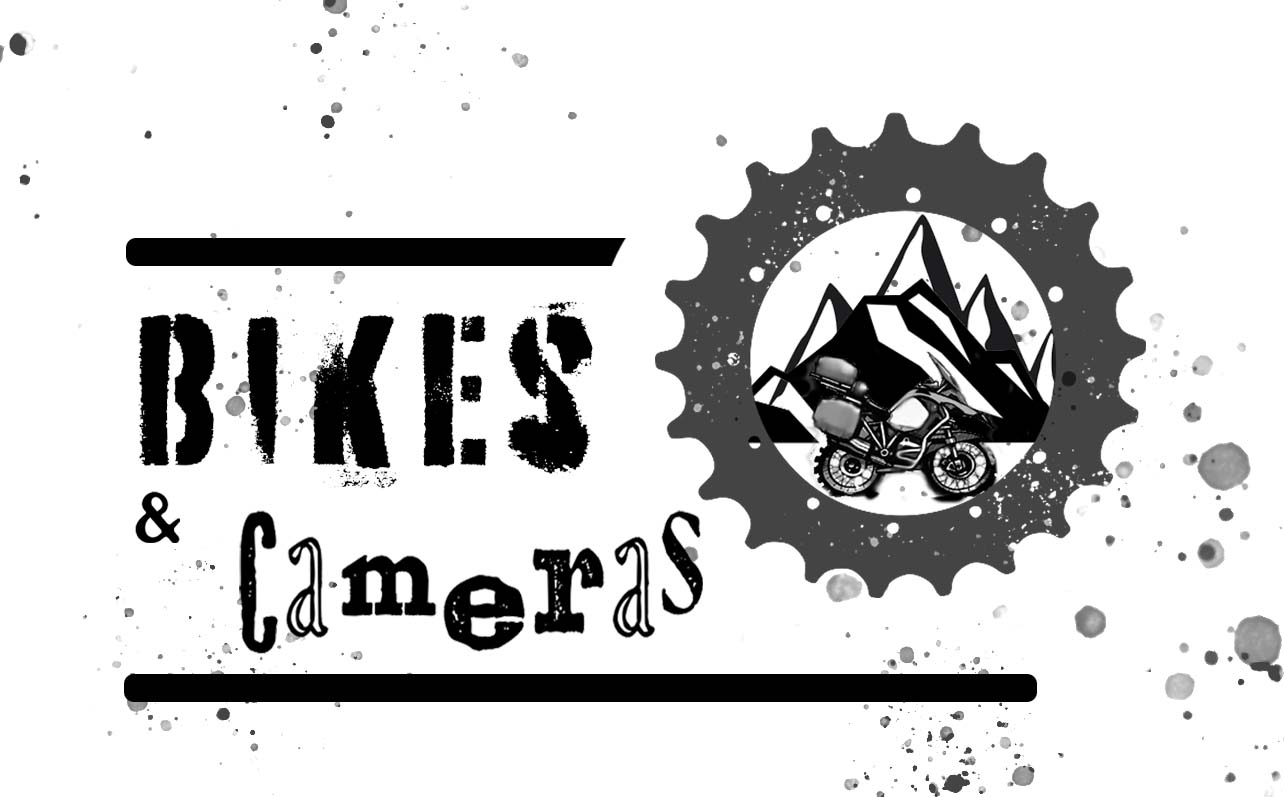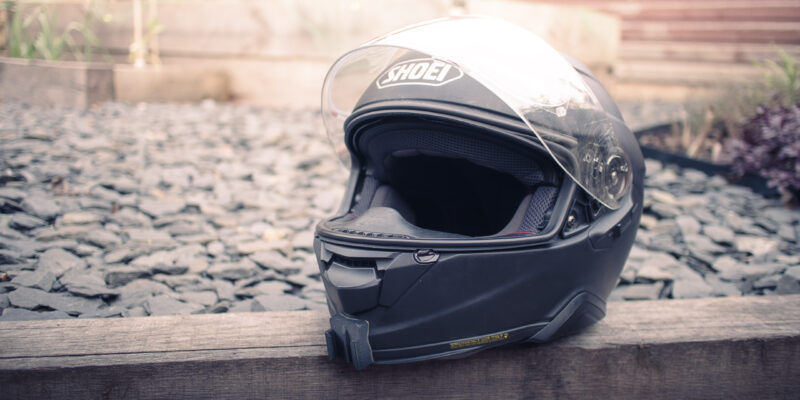Introduction
Buying a motorcycle helmet will be one of the most important, if not the most important purchase you make when taking up motorcycling. But there’s a world of options and good and bad advice out there, so where do you start with choosing the right lid for your new adventures? This guide gives you my personal experience of buying and owning a few helmets (and getting it wrong!) so hopefully, you find the process easier.
The importance of wearing a motorcycle helmet
I think it’s safe to say that a motorcycle safety helmet is generally understood these days to be a key piece of kit. Hopefully, it goes without saying that you should wear one, otherwise you probably wouldn’t be here!
Getting the right fit.
Getting the right fit for your lid is incredibly important and, in my opinion, has so much bad advice given.
If you have anything the like same experience I did, you’ll find that everybody tells you your helmet needs to be SUPER tight. You’ll try a helmet on, it will feel comfortable, and the shopkeeper will tell you it is too loose.
Snug, not tight.
A motorcycle helmet should not be TIGHT. It should be SNUG. A tight helmet that squeezes your head will give you pressure points, that within half an hour to an hour will give you a burning sensation on the tighter parts of your skull, and a headache while you’re riding. This will distract you from the road and put you in danger, so it’s important that your helmet fits you correctly. The obsession with having a super tight helmet needs to end.
Head first, face second
The next piece of rubbish advice you’ll get when fitting your helmet is that the cheek pads should squeeze your face and make you look like a hamster.
While the helmet should hold itself still via the cheek pads giving your face a gentle smush, this isn’t the place to start with fitting a helmet. There’s more flex in your face, and the cheek pads themselves. On top of that, a lot of helmets with let you change out the thickness of the cheek pads – a feature that is available for a lot of helmets, sometimes you have to pay for a change in cheek pads, and other times you won’t.
What you can’t do is:
- Smush your scull
- Change the size of the actual shell of the helmet (you can technically change the scull padding, but this will just go up or down a full size, in which case, just try the next size up or down)
- ‘Break in’ the head part of the helmet – it just doesn’t happen. The cheek pads will break-in, and the head size of the helmet will not get any bigger if it is too small for you.
So, measure your head, and fit the helmet to your head first, then look at how well the helmet fits your face by adding larger cheek pads if you need to.
Getting the right size: measure your head.
It’s difficult to tell what size your helmet should be, the shopkeeper will ask you if it feels tight, and if you say no, he or she will give you a smaller size. And you won’t know which way is up.
The flip side to this is that a helmet might not be too small or too big for you, it might just be the wrong shape.
All helmets have sizing charts – measure your head around your forehead where the main brim is going to sit, and around the largest part of the back of your head. Match this size up to the sizing chart of the make AND model of the helmet to see what size you are.
Your head size needs to be within the range that the manufacture specifies. If you find that you are in the range, but the helmet feels uncomfortable, it feels too tight on your forehead or it squeezes the sides of your head – you can relatively sure it’s the shape that’s the problem, not the size – so don’t be tempted to go up a size – try and different model or brand of helmet and see how you get on.
A word on head shape.
We’ve talked about getting the right size, now it’s about the right shape. I’m afraid this is going to just be case of trying a bunch of helmets. It can be very tempting to try and get a brand you like to fit and convince yourself it’s ok – don’t be tempted. Focus on getting the right fit first, and then find the colour you like in that helmet.
Unfortunately, there’s no consistent way to know what helmets fit your head shape – there isn’t much information from brands on what they aim for. Once you’ve found a brand that does fit you well, you will probably find that you can generally stick with that brand in the future.
Whether you have a round head, an oval head or a round oval head is all kind of a moot point really. As you won’t be able to do much with that information – you just have to try the helmets on (making sure they are the right size first of course!)
How it should feel
We’ve talked about your snug vs tight. You should also feel that the helmet is holding onto your face. If you shake your head the helmet should more or less go with you, you shouldn’t feel it sliding around. You shouldn’t be able to fit much more than the absolute tip of your pinking up in between your forehead and the shell of the helmet. You shouldn’t be able to rock the helmet backward and forwards on your head – a small amount of movemen is okay (you have to be able to take the helmet on and off after all) but you should have big swings in positing the helmet can sit.
Helmet types and styles
First off – lets talk about your face.
For me, if you’re buying a helmet for safety there are two main types of helmet. Full-face and modular.
Anything outside of this isn’t a helmet for safety, it’s a helmet for complying with the law and maybe a helmet for fashion, but it’s not for safety. Don’t bother with open-face helmets or any helmet that doesn’t have some kind chin bar. If you’re going to spend all that money and leave your face open to getting ripped off when you crash, then what was the point?
A full-face helmet is always going to give you the most protection, while a modular helmet (on that allows you to open the front of your helmet by lifting the chin bar) gives a similar level of protection (in most cases) with the added convenience that you can open the face to make it easier to chat to your mates when you’re not riding, or to chat to the nice lady at the petrol station without worrying her that you’re going to rob the place.
That being said, you then have some options within these parameters
Touring/sport-touring helmets
This is where you will most likely sit if you are concerned more with comfort and safety, within a sensible price point. A helmet in this category will likely be slightly less sleek and aesthetic – but chances are it will be more comfortable, have a decent amount of thick foam protection (often they are rated higher for safety in schemes like SHARP) You’ll also typically get lower wind noise for less fatigue on long rides.
Sport helmets
Sports helmets tend to a bit snazzier in appearance, they can also be more aerodynamic and overall smaller looking on the outside, making you a bit less bobble headed. They do sometimes tend to be a bit noisier though, as aerodynamics and performance are prioritised over comfort and practicality.
Adventure/dual-sport helmets
Adventure or dual sport style helmets tend to a have a peak, and more room around the chin bar to allow air to flow when you’re riding in hotter temperatures and slower speeds riding off-road, some also have mounting points for goggles, again for the off-road focused rider. You’ll see a lot of adventure bike owners sporting these kinds of helmets. I personally would warn against this kind of lid unless you’re actually going to be doing off-road adventuring. The peak might look cool, and maybe shade the sun a bit for you, but what it’s really designed for is protecting your face from your mates roost (dirt) as he speeds off in front of you. On the road, they just add a sail for the wind to catch and can give you all kinds of uncomfortable turbulence and wind noise.
Motocross helmets.
Motocross helmets have a lot of the same features as an adventure helmet, but go that step further to be more off-road focused. Forget comfort and noise protection – but enter ultimate ventilation.
A lot of motocross helmets are also road legal. But really you only want to go down this route if you’re spending 95% of your time off road.
Does price matter?
So here’s the thing. The price you pay for your helmet isn’t everything. There are ‘safe’ helmets at lots of different price points. That being said. The amount you pay for a helmet does make a difference. And in my view, you do tend to get what you pay for.
There are two ends of the spectrum to consider. At the low end, if the RRP of your helmet is less than £50, you should be extremely skeptical at how the manufacturer has been able to design, build, test, re-test, re-test again, get certified and ship that helmet to you for less than £50. You can find deals on these helmets that bring down the price point, but chances are you won’t see helmets for less than this in reputable motorcycle gear shops. Stay the hell away from Amazon when it comes to buying motorcycle helmets.
As you go up the scale, you get into more well-renowned brands such as the Shoei and Arai’s that typically have their entry-level helmets around the £250 mark. Going up in price from here, you get into lighter, strong shell materials, more options of shell size, and generally slightly more advanced technology.
This is just my assessment but passed the £500 mark, you start to get diminishing returns in terms of improvements. By this price point, you’ve probably covered 98% of the helmets worth considering.
For the non-premium brands, you can still get a decent lid. My personal view would be that a price point of around £150 can be considered a reasonable quality, but an affordable helmet.
There’s a great video here from Bennetts on whats inside cheap vs expensive helmets that might help you decide where to spend your money
Other features and factors to consider
Ventilation
Ventilation can make a reasonable amount of difference when the weather is hot. Most helmets have vents of some kind these days once you get to a certain price point – is one type of vent better than another? who knows. As a minimum look for vents that close so you can close them when it’s cold, or if that particular stream of air annoys you when riding. Look for a lid that has chin venting to help keep your visor clean, and some sort of venting in the forehead to keep your head cool when it’s hot.
Weight
Lighter helmets will generally be more expensive, I personally have been able to tell a huge amount of difference between the helmets I’ve owned. When it comes to weight, just try some on and see how you feel about them. For your first helmet, the specific weight is probably not going to be high on your list of concerns.
Visibility
Different types of helmets have different sized viewports. Again, this is one to try for yourself. You will struggle to find a main brand helmet that doesn’t give you decent visibility, but you might find that some just feel better to you than others in this respect.
Drop down visors vs tinted visors
A lot of helmets these days have drop down visors. I highly recommend going down this route. The alternative is putting a tinted visor on your lid for sunny days, which when it’s sunny is a much more pleasant view, and you look cooler at the same time. The problem is that really you have to carry your clear visor with you at all times unless you’re really sure it’s not going to get dark when you’re out (when you’re a new rider, you’re probably going to get caught out at some point!) and this is a PITA. Some brands like Arai won’t add visors to their lids on the basis of safety, but their are many main brands that do, including Shoei. For me personally, my first lid had a visor, my second didn’t and I missed it from day one, all the way to eventually buying a new helmet that does now have a visor. For touring especially, this is an absolute essential feature in my book to be able to switch from sunny to gloomy quickly and easily while riding.
Noise reduction
Earplugs. I don’t care how quiet the internet says your helmet should be, in my experience no helmet is every really that quiet. Earplugs are the way forward, foam 3m ones I’ve found to be best as have many others, and this takes the
D-Ring vs Ratchet system
I bet you didn’t think you’ve have to care about the type of fastener on the straps on your helmet! The die-hards will tell you the classic D-ring system is the way to go, and it definitely does have its pros. This simple strap, consisting of two metal D-shaped rings may look basic but is actually incredibly secure. The other option tends to be some sort of ratchet system. I’ve had both, and thought I might not like the ratchet after years with the ol’ D-ring setup, but actually have gotten used to it it’s perfectly fine, and if anything less of a faff. On the cheaper end of the helmets though, I’d probably opt for the classic D-ring option.
Where and how to buy a helmet
Hopefully, by now you’ve started to glean that you need to try on helmets before you buy them. Does that mean buying online is out of the question? Luckily, no! While most stores, both on and offline, will refuse to take a helmet back if it has been used – most will take them back provided you haven’t taken the stickers off the visor. Online stores like sportsbikeshop.co.uk and infinitymotorcycles.com have really good return policies and make it super easy to return you helmet if it’s not right for you. So you can (while not totally ethical) go to a store where you can try the helmet on, and then buy online, or if you know you’re a good fit for certain brands, order your helmet online, sit on the sofa watching TV for a bit while wearing it (we’ve all done it!) and make sure it fits and is comfortable before you start taking all the stickers off.
My advice, though, is that if it is your first lid, and you’ve never tried any on – the chances of getting it right based on looks alone on a website is incredibly low. Go try some helmets on first before trying to buy something online.
How safe is my motorcycle helmet? Safety standards to be aware of.
We want to be safe in our new lid. We’re probably going to spend a reasonable amount of money on a new helmet and we want to know that we’re getting the safety we’re paying for. Different safety standards can be confusing here’s an overview of the standards you’re likely to hear about.
When it comes to motorcycle helmet safety standards, there are several important ones to consider, depending on where you live. In the United States, the main standard is set by the Department of Transportation (DOT) and is known as the FMVSS 218 standard. In the UK, the main standard is set by the Economic Commission for Europe (ECE) and is known as the ECE 22.05 standard.
DOT and ECE standards set minimum safety requirements for motorcycle helmets, including impact resistance, penetration resistance, retention system strength, and more. These standards help ensure that helmets sold in these regions provide adequate protection in the event of an accident. It’s important to note that some helmets may meet both the DOT and ECE standards, as well as other international safety standards, such as the Snell Memorial Foundation standards.
The Snell Memorial Foundation is a non-profit organization that was established in 1957 to promote helmet safety and improve helmet standards. Snell testing is an independent, third-party testing process that goes beyond the minimum safety requirements set by DOT and ECE standards. Snell tests helmets for a variety of factors, including impact absorption, retention system strength, shell penetration, and more.
Helmets that meet Snell standards are considered to be some of the safest helmets on the market. However, it’s important to note that Snell certification is not a requirement for a helmet to be legally sold as a motorcycle helmet in the United States or the UK. While Snell certification is a good indicator of helmet safety, it’s not the only factor to consider when choosing a helmet.
In the UK, there is also a helmet safety rating system known as the SHARP (Safety Helmet Assessment and Rating Programme) system. SHARP is a government-funded program that tests and rates motorcycle helmets based on a five-star system. The SHARP rating system goes beyond the minimum safety requirements set by ECE standards and tests helmets for additional factors such as impact performance at different speeds and angles. The SHARP system is designed to help riders make informed decisions when choosing a helmet, and helmets with a higher SHARP rating are considered to be safer than helmets with a lower rating.
When choosing a helmet, it’s important to look for helmets that meet at least one of these standards and have undergone testing by independent, third-party organizations. This will help ensure that the helmet you choose will provide adequate protection in the event of an accident.
But don’t get bogged down in any one specific safety standard. Each one of these standards tests differently – you might find a Snell-rated helmet that scores low on the sharp scores and vice versa you might find a 5-star sharp helmet that Snell doesn’t pass. Some of the major brands no longer sign up to schemes, because they don’t believe the testing practices are true to life. The leading brands such as Arai and Shoei are considered to be some of the highest quality and safest helmets on the market, trusted by race teams riding bikes travelling 200mph. So take all the advice available to you when choosing a helmet.
Most importantly the helmet has to fit you properly. Without a good fit, the safety testing all becomes irrelevant.
Maintaining and Replacing Your Helmet
You will want to look after your helmet so that it looks after you. Here’s how.
Helmet care and maintenance
Looking after your helmet is actually pretty straightforward, and doesn’t really need to be over thought. Most helmets will have remove-able liners these days that you can put in the washing machine which is a nice feature to have, if you go on long trips your helmet will start to absorb all sorts of sweat and grime from your head and will get nice and stinky. It’s helpful to be able to wash this out from time to time.
To clean your helmet on the outside, again, you don’t need to overthink this in my opinion. A wet microfibre cloth is just fine. You can but special helmet cleaners if you want…I mean…you know… if you’re the kind of person with time on your hands.
When to replace your helmet
There are 3 scenarios to replace your helmet
1. It’s been used in a crash and/or otherwise damaged
If you crash with your helmet on, it’s time for a new helmet. End of story. You might not remember feeling like you hit your head – that’s good! the helmet worked! but chances are you’ll see the scratch and other damage, and even if you don’t – the safest bet is that it’s time for a new lid. The foam in your helmet is for single use, it works by compressing to reduce the impact of a crash, but once it’s compressed, it can be compressed and performed in the same way again.
The other one is if you damage your helmet in some other way – it has a heavy drop, it gets a crack in the shell, the chin strap starts to frey – all signs it’s time for a new lid. Do you need to change it if you drop it off your bike at a standstill? This is a topic of great debate and a difficult one to answer. My approach (and I by no means give advice on this topic – but this is my approach) If I drop my £500 Shoei GT Air 2 lightly because I knocked it off my bike, and it’s a gentle drop such there’s no visible damage to the shell – I don’t worry too much about it. The likelihood of the foam having been compressed is very low in my view – my head wasn’t in the helmet to squish the foam and my understanding (from the internet!) is that I should be good to carry on. If you are in any doubt at all about your helmet though, replace it!
2. It’s old.
Helmets are generally considered to have a life of 5 years – and most manufacturers recommend replacing them after 5 years. I suspect there is a degree of manufacturers wanting to sell more helmets and I’d also expect there is a good degree of tolerance in this, in that you want to replace your lid WELL before the helmet materials start to degrade and become less performant. That being said – the 5-year rule is all the excuse I need to buy a new lid.
3. You’re bored of it.
It’s ok to want to have nice things. If you’re bored with your current helmet and you want to look cooler than your current helmet allows. It’s ok to replace it. Go ahead. I give you permission. YOLO.
Final thoughts…
Choosing your first lid can be a minefield, it can maybe even be a little stressful if you’re struggling to find one that feels good in your price range. If you only take one piece of advice, it’s to keep trying helmets on until you find one that fits your properly and don’t just settle for the best option that particular shop has.



